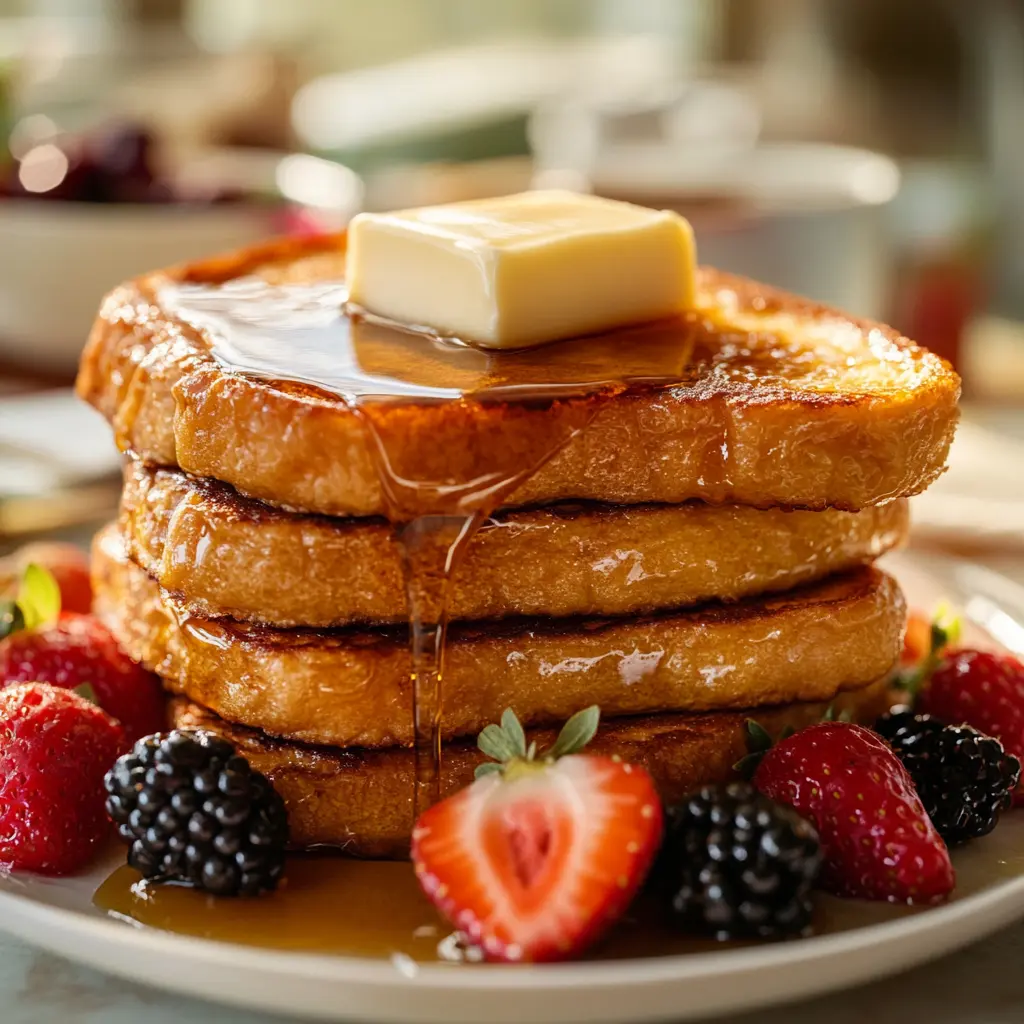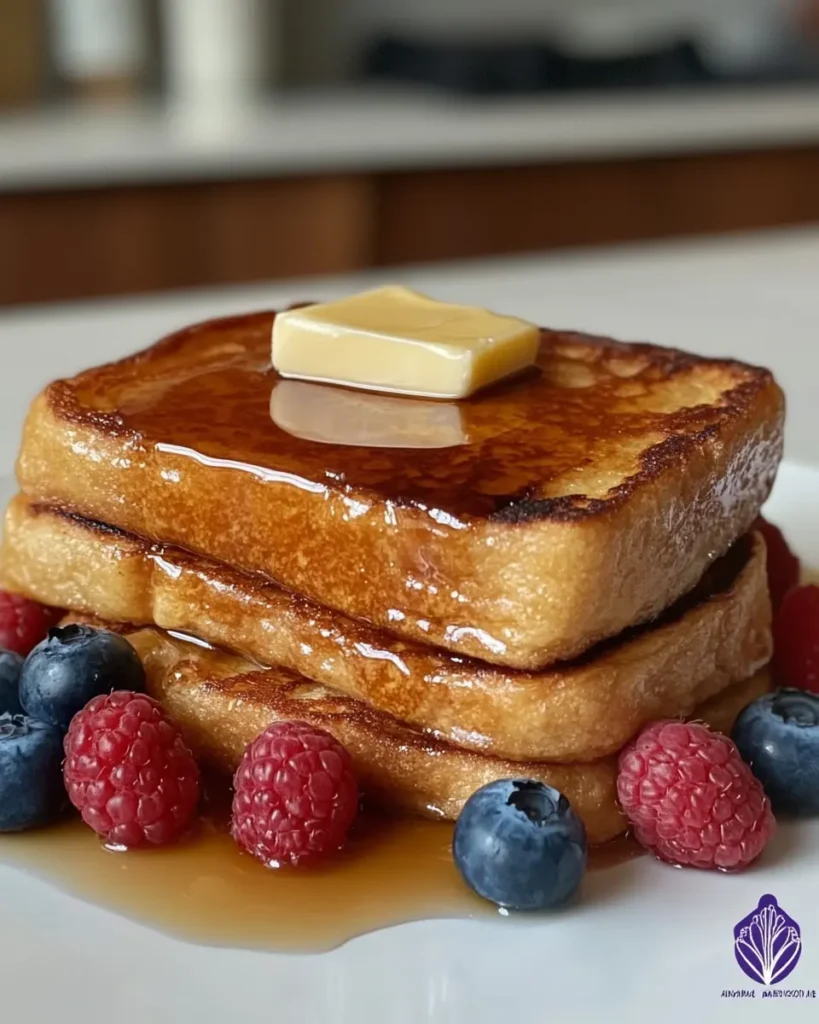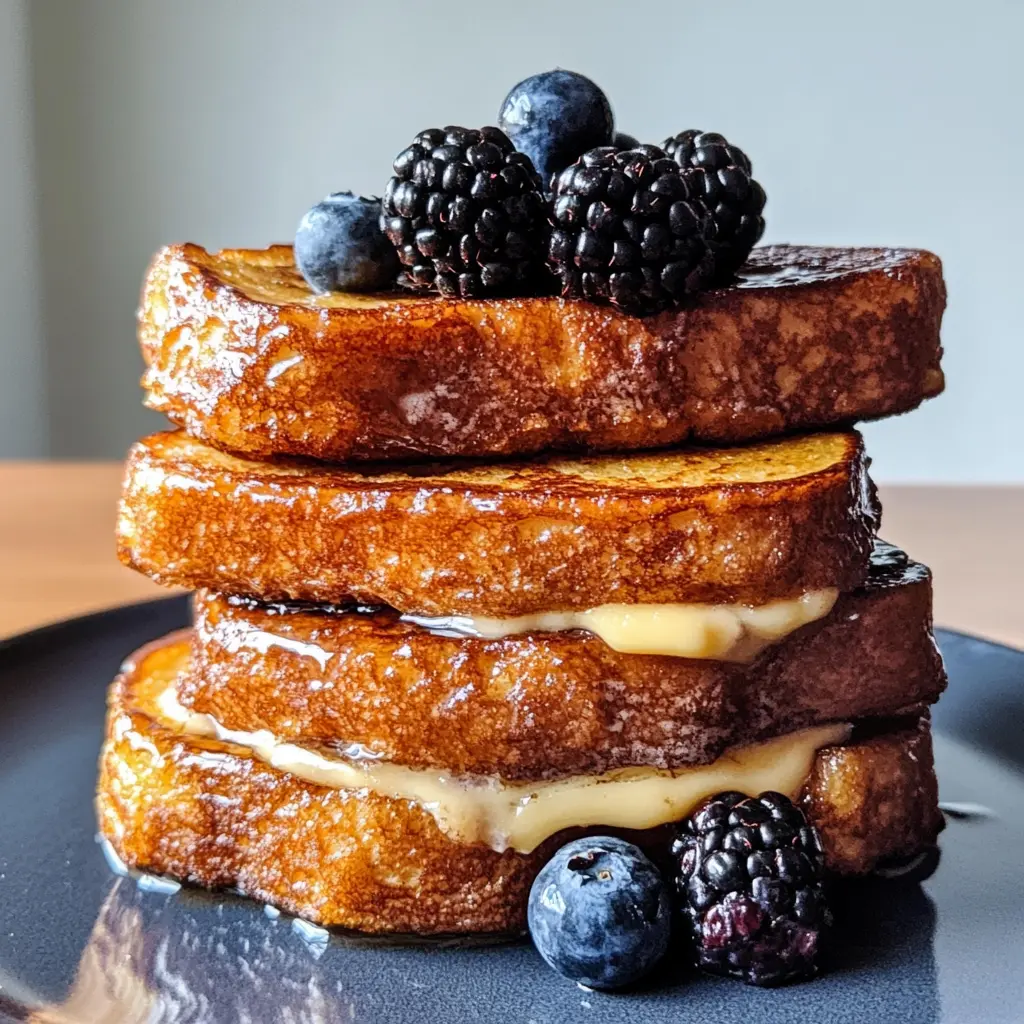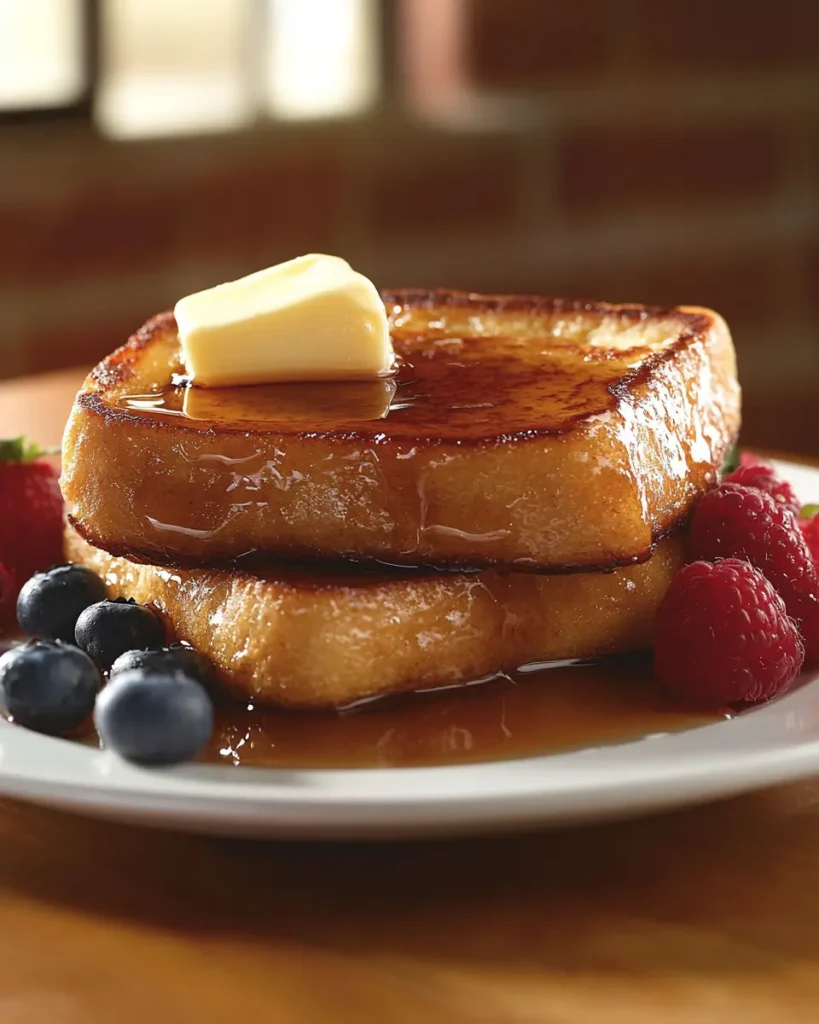Introduction
Introduction to French Toast for Dinner
French toast, typically associated with breakfast, can also make for a delightful dinner option. The versatility of French toast allows it to transition seamlessly from morning to evening meals. Whether you prefer it sweet or savory, French toast can be adapted to suit various dinner themes and tastes.
Why consider French toast for dinner? It’s quick and easy to prepare, making it perfect for busy weeknights. Additionally, French toast can be customized with a variety of toppings and sides to create a balanced and satisfying meal. From nutritious ingredients to indulgent flavors, exploring the possibilities of French toast for dinner opens up a world of culinary creativity.
Nutritional Considerations for French toast for dinner
Is the Toast Healthy for Dinner?
When considering if French toast is a healthy option for dinner, it’s essential to look at its nutritional profile. Traditional French toast includes bread, eggs, milk, and a sweet element like syrup or sugar. This combination provides a good mix of protein, carbohydrates, and fats.
To make a healthier French toast for dinner, focus on balancing macronutrients. Include sources of lean protein, healthy fats, and fiber to keep the meal balanced. For example, adding toppings like avocado, lean meats, and fresh vegetables can enhance the nutritional value of your dinner. Check out healthy French toast ideas for more tips.
Caloric Content
The calorie content of French toast can vary depending on the ingredients used. On average, a serving of French toast can contain between 200 to 300 calories, primarily from the bread and egg mixture. Managing portion sizes is crucial to ensure that the meal fits within your dietary goals.
Healthy Modifications
Here are some tips for making French toast healthier:
- Use Whole Grain Bread: Whole grain bread adds fiber and nutrients, making your meal more filling and nutritious.
- Reduce Sugar and Fat Content: Substitute sugary syrups with natural sweeteners like honey or fresh fruit. Use skim milk or plant-based milk to cut down on fat.
- Add Vegetables and Lean Proteins: Incorporate ingredients like spinach, tomatoes, and grilled chicken to boost the nutritional content and make the meal more balanced.

Savory French Toast for Dinner
Savory French Toast Recipes
Cheese and Herb French Toast:
- Ingredients: Thick slices of bread, eggs, milk, shredded cheese (cheddar or mozzarella), chopped herbs (parsley, thyme), salt, and pepper.
- Preparation: Whisk eggs, milk, salt, and pepper together. Dip the bread slices in the mixture, then coat with shredded cheese and herbs. Cook in a skillet until golden brown and the cheese is melted. Learn more about savory French toast variations.
Bacon and Avocado French Toast:
- Ingredients: Bread, eggs, milk, cooked bacon, sliced avocado, salt, and pepper.
- Instructions: Prepare the egg mixture and dip the bread slices. Cook in a skillet until golden brown. Top with crispy bacon and sliced avocado before serving.
Spinach and Feta French Toast:
- Ingredients: Bread, eggs, milk, fresh spinach, crumbled feta cheese, garlic powder, salt, and pepper.
- Cooking Tips: Sauté spinach until wilted. Prepare the egg mixture with garlic powder, salt, and pepper. Dip the bread, cook in a skillet, and top with sautéed spinach and feta cheese.
Pairing Savory French Toast with Sides
Salads:
- Fresh Green Salad: A simple green salad with mixed greens, cherry tomatoes, and a light vinaigrette complements savory French toast perfectly.
- Tomato and Cucumber Salad: Combine diced tomatoes, cucumbers, red onions, olive oil, and lemon juice for a refreshing side.
Roasted Vegetables:
- Best Vegetables to Roast: Carrots, bell peppers, zucchini, and asparagus roast well and add color and nutrients to your meal.
- Seasoning Tips: Toss vegetables with olive oil, salt, pepper, and herbs like rosemary or thyme before roasting.
Proteins:
- Grilled Chicken: Simple grilled chicken breast seasoned with herbs can make a hearty side.
- Sausages: Cooked sausages, whether pork, chicken, or turkey, add a savory component to the meal.
Sweet French Toast for Dinner
Sweet French Toast Recipes for Dinner
Cinnamon and Apple French Toast:
- Ingredients: Bread, eggs, milk, cinnamon, sliced apples, butter, brown sugar.
- Instructions: Sauté apple slices with butter and brown sugar until tender. Prepare the egg mixture with cinnamon, dip the bread, and cook in a skillet. Top with the sautéed apples. For more sweet ideas, visit French toast for dinner.
Berry Compote French Toast:
- Ingredients: Mixed berries (strawberries, blueberries, raspberries), sugar, lemon juice, bread, eggs, milk.
- Preparation Method: Cook berries with sugar and lemon juice to make a compote. Prepare and cook the French toast, then top with the warm berry compote.
Banana and Nut French Toast:
- Ingredients: Sliced bananas, chopped nuts (walnuts, pecans), bread, eggs, milk, cinnamon.
- Recipe and Tips: Sauté bananas with a little butter and cinnamon. Dip bread in the egg mixture, cook, and top with the bananas and nuts.
Complementary Sides for Sweet French Toast
Yogurt and Granola:
- How to Serve: A bowl of Greek yogurt topped with granola and a drizzle of honey pairs well with sweet French toast.
Fresh Fruit:
- Best Fruits to Pair: Berries, sliced bananas, and citrus segments add freshness and a burst of flavor.
Nuts and Seeds:
- Adding Crunch and Nutrition: Sprinkle toasted almonds, walnuts, or a mix of chia and flaxseeds over your French toast for added texture and nutritional benefits.
Beverage Pairings
Best Drinks to Serve with French Toast for Dinner
Wine Pairings:
- Sweet Options: A late-harvest Riesling or a Moscato pairs well with sweet French toast. These wines have enough sweetness to complement the sugary toppings without overpowering them.
- Savory Options: A light, fruity red wine like a Pinot Noir complements savory French toast dishes. The subtle flavors of Pinot Noir enhance the savory ingredients without clashing.
Non-Alcoholic Beverages:
- Sparkling Water with Citrus: Add slices of lemon, lime, or orange to sparkling water for a refreshing drink that cleanses the palate between bites.
- Herbal Teas: Chamomile, mint, or rooibos tea can be soothing and pair well with both sweet and savory French toast. These teas offer a calming end to the meal without adding any caffeine.
Coffee and Tea
Suitable Options for Evening Consumption:
- Opt for decaffeinated coffee or teas that are low in caffeine, such as herbal teas, to avoid disrupting sleep. These beverages can still provide a rich and comforting flavor profile.
How to Brew the Perfect Cup:
- Coffee: Use fresh, high-quality beans, grind them just before brewing, and use filtered water. Brew at the right temperature (around 200°F or 93°C) to extract the best flavors.
- Tea: Use fresh, high-quality tea leaves, and steep them at the correct temperature and time for the specific type of tea. Generally, herbal teas should be steeped for about 5-7 minutes in boiling water.
Preparing French Toast for Dinner
Cooking Techniques
Perfecting the technique for cooking French toast can make all the difference, especially when serving it for dinner. Here are some essential tips to ensure you achieve the perfect texture and flavor.
Choosing the Right Bread: The type of bread you use is crucial. Opt for thick slices of bread that can soak up the egg mixture without falling apart. Brioche, challah, and sourdough are excellent choices due to their texture and flavor.
Preparing the Egg Mixture: For a standard egg mixture, whisk together eggs, milk (or cream), and a pinch of salt. For savory French toast, add herbs, spices, or even grated cheese. For sweet French toast, incorporate vanilla extract, cinnamon, and a bit of sugar.
Soaking the Bread: Ensure the bread soaks up enough of the egg mixture to be fully saturated but not soggy. Typically, soaking for about 20-30 seconds per side is sufficient, depending on the thickness of the bread.
Cooking on Medium Heat: Cook French toast over medium heat. This allows the bread to cook through evenly and develop a golden-brown crust without burning. Preheat your skillet or griddle and use butter or oil to prevent sticking.
Avoiding Common Mistakes:
- Overcrowding the Pan: Cook in batches if necessary to ensure each piece has enough space to cook evenly.
- Incorrect Temperature: Too high a temperature can burn the exterior while leaving the inside undercooked. Too low a temperature can make the toast soggy and limp.

Make-Ahead and Reheat Tips
French toast can be prepared in advance and reheated, making it convenient for dinner.
Preparing in Advance: Cook the French toast as usual, then let it cool completely. Arrange the slices in a single layer on a baking sheet and freeze. Once frozen, transfer the slices to a freezer-safe bag or container. This method prevents the slices from sticking together.
Reheating:
- Oven: Preheat the oven to 350°F (175°C). Place the French toast slices on a baking sheet and heat for about 10 minutes, flipping halfway through to ensure even heating.
- Toaster Oven: Similar to the oven method, but often quicker and more convenient for small batches.
- Stovetop: Heat a skillet over medium heat and cook the French toast slices for a few minutes on each side until warmed through.
- Microwave: While not ideal due to potential sogginess, you can microwave French toast for about 1-2 minutes if in a pinch. Place a damp paper towel over the slices to retain moisture.
Plating and Presentation
Making dinner French toast visually appealing can enhance the dining experience.
Arranging the Toast: Stack the slices in an overlapping pattern or in a neat stack. For savory dishes, place the toast alongside the main components (like bacon or avocado) rather than on top to maintain texture.
Garnishing Ideas:
- Savory French Toast: Sprinkle chopped fresh herbs (like parsley or chives), grated cheese, or a light drizzle of olive oil.
- Sweet French Toast: Dust with powdered sugar, a drizzle of maple syrup or honey, fresh berries, or a dollop of whipped cream.
Using Contrasting Colors and Textures: Combine different textures and colors to make the dish more appealing. Bright greens from herbs or salads, vibrant reds and blues from berries, and the golden brown of the toast itself create a visually attractive plate.
Serving on Attractive Dinnerware: Using nice plates and arranging the food carefully can elevate the presentation. Consider the color and design of the plates to complement the food.
Adding Side Dishes Thoughtfully: Place side dishes like salads or roasted vegetables in small bowls or neatly on the plate to keep them separate from the French toast, ensuring they maintain their distinct flavors and textures.
Exploring Variations
One of the exciting aspects of having French toast for dinner is the variety of flavors and combinations you can explore.
Savory French Toast Variations:
- Italian-Inspired French Toast: Use Italian bread, and add Parmesan cheese, oregano, and garlic to the egg mixture. Serve with marinara sauce and a side of sautéed spinach.
- Mexican French Toast: Incorporate cumin, chili powder, and cilantro into the egg mixture. Top with black beans, avocado, salsa, and a sprinkle of queso fresco.
- French Onion French Toast: Caramelize onions and add them between two slices of French toast with Gruyère cheese. Serve with a beef broth dipping sauce.
Sweet French Toast Variations:
- Tropical French Toast: Add coconut milk to the egg mixture. Top with fresh pineapple, mango, and a sprinkle of toasted coconut flakes.
- Nutty Banana French Toast: Use almond milk in the egg mixture. Top with sliced bananas, a drizzle of almond butter, and chopped nuts.
- Chocolate French Toast: Add cocoa powder and a bit of sugar to the egg mixture. Serve with a chocolate sauce and fresh strawberries.
Creating Balanced Meals
To ensure your French toast dinner is balanced, consider incorporating a variety of food groups.
Proteins:
- Eggs: Scrambled, poached, or as part of the French toast itself.
- Meat: Bacon, sausage, or grilled chicken add necessary protein to the meal.
- Legumes: Black beans or lentils can be excellent additions for vegetarians.
Vegetables:
- Roasted or Sautéed Vegetables: Bell peppers, zucchini, spinach, or mushrooms add color and nutrients.
- Salads: Fresh green salads or vegetable-based salads like tomato and cucumber provide a refreshing contrast.
Healthy Fats:
- Avocado: Adds creaminess and healthy fats.
- Nuts and Seeds: Almonds, walnuts, chia seeds, and flaxseeds contribute healthy fats and a satisfying crunch.
Carbohydrates:
- Whole Grain Bread: Opt for whole grain or multi-grain bread to increase fiber content.
- Fruit: Fresh fruit or fruit compotes add natural sweetness and additional nutrients.
Tips for Serving and Eating
Serving Family Style: Consider serving French toast and its accompaniments family-style, where everyone can help themselves. This method encourages interaction and allows everyone to customize their meal.
Portion Control: Serve moderate portions, especially if you’re incorporating rich ingredients like cheese, bacon, or sweet toppings. Balancing portions ensures you enjoy the meal without overindulging.
Balancing Sweet and Savory: Combining sweet and savory elements on the same plate can create a delightful balance. For instance, pair sweet French toast with a savory side like bacon or a small green salad.
Encouraging Experimentation: Encourage your family or guests to experiment with different combinations of toppings and sides. This can make the meal more enjoyable and interactive.

Conclusion
French toast is not just a breakfast delight but can be transformed into a delicious and versatile dinner option. By incorporating savory and sweet variations, balancing flavors, and adding nutritious sides, you can enjoy a well-rounded meal. Experiment with different recipes and pairings to discover your favorite combinations. Whether you opt for a traditional approach or a creative twist, French toast for dinner can be a satisfying and enjoyable choice. Embrace the versatility of this dish and make your dinner time both fun and flavorful. Enjoy your French Toast Feast at any time of the day!
Summary of Key Points: In this guide, we’ve explored how French toast can be a versatile and satisfying dinner option. From understanding its nutritional profile and making healthy modifications to discovering savory and sweet recipes, French toast offers endless possibilities for a delicious evening meal.
Encouragement to Try Different Variations: Don’t hesitate to experiment with different ingredients, flavors, and combinations. Whether you prefer savory or sweet, there’s a French toast dinner recipe to suit every palate.
Final Thoughts on Enjoying French Toast at Any Meal: French toast isn’t just for breakfast. With a little creativity, it can be a delightful and balanced dinner option that adds a touch of comfort and indulgence to your evening meals. Enjoy the process of making and savoring your French toast dinner!
FAQs
Can you eat French toast for dinner?
- Absolutely! French toast can be a versatile and satisfying dinner option, offering both sweet and savory variations.
What are some savory French toast ideas?
- Try cheese and herb French toast, bacon and avocado French toast, or spinach and feta French toast for a savory twist.
How can I make French toast healthier for dinner?
- Use whole grain bread, reduce sugar, add vegetables, and incorporate lean proteins to make a balanced meal.
What sides go well with dinner French toast?
- Savory sides like salads, roasted vegetables, and grilled proteins or sweet sides like yogurt, fresh fruit, and nuts.
Is French toast a good option for a balanced dinner?
- Yes, with the right ingredients and sides, French toast can be part of a balanced and nutritious dinner.



